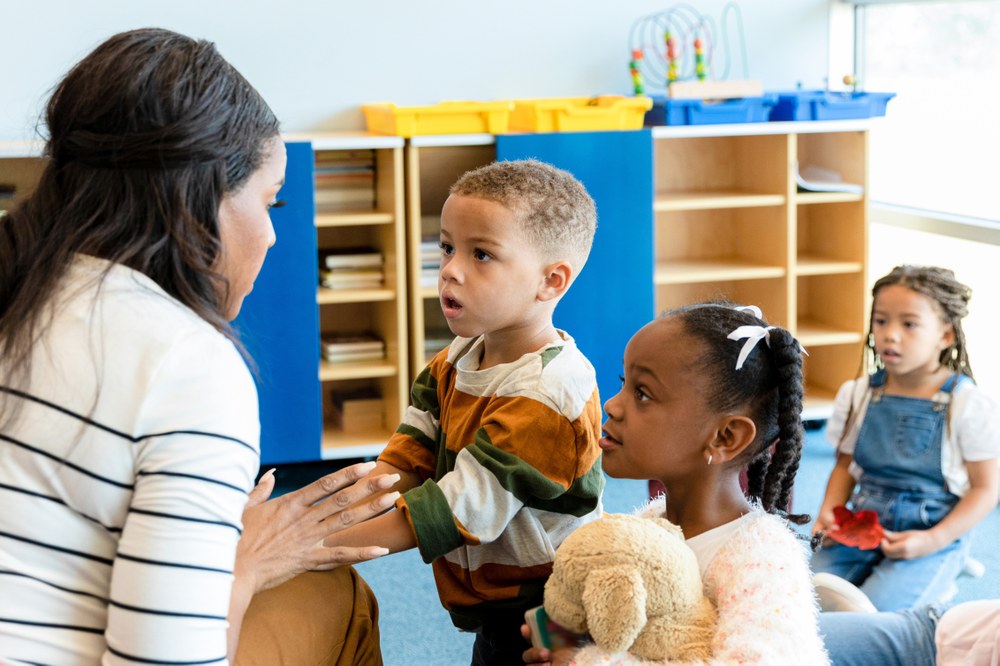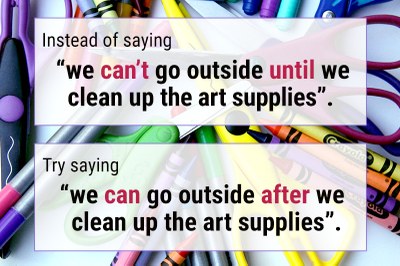Posted: June 21, 2023
Coercive patterns occur when a child engages in an undesirable behavior, a caregiver responds in an overly harsh manner, and the child responds by escalating their undesirable behavior. This cycle does little to address the behavior or prevent the behavior from occurring again in the future, and instead reinforces the undesirable behavior.

Teacher responding gently to a child, addressing the root behavior.
As an example, imagine a child who when asked to pick up refuses and yells "No!" The caregiver responds with frustration and says the child needs to go to time-out. While in the time-out area the child sticks out their tongue at the teacher, and the teacher responds by taking away outdoor play time from the child. This continued escalation of child's behavior and caregiver's negative response is a very common example of a coercive pattern and it does little to address the initial behavior (the child refusing to pick up) and actually reinforces the undesirable behavior.
The problem with coercive patterns
Once these cycles of behaviors and responses are established, they can be very difficult to get out of. In addition, caregivers may feel like they have to increase the punishment to get the desired reaction from the child. However, this leads to increased frustration by the child and a more extreme negative behavior. It is very important to get out of these cycles of escalation between child behavior and caregiver response as they can have a very detrimental impact on both the child's and your own well-being. Children do not learn new behaviors through punishment. This is something we have now known for decades. Punishment can lead to short-term repression of the behavior, but once the punishment is removed the behavior will return and will often be more extreme. You can think of any sort of behavioral challenge as a learned response to an unmet need. If we do not respond to the root of the behavior, we are not going to address it appropriately or prevent the situation from occurring again.
Avoiding punitive interactions
Responding with punishment--like sending a child to time-out--may seem to be effective in the short-term, but this does not address the cause of the behavior and can often produce additional challenging behaviors. While there may be times when a child needs to be removed from a situation, for example harming another child, a "time-in" where you sit with the child to discuss the situation and how they're feeling can be much more effective than a time-out. This likely will not only address the behavior but can help you establish a close bond with the child. Also, think about how things are phrased in the classroom. Caregivers often unintentionally word commands like a threat.

For example, saying something like "we can't go outside until we clean up the art supplies" sounds to a child like there is a possibility for punishment. However, by altering the phrasing slightly in a more positive way to say, "we can go outside after we clean up the art supplies," children are much more likely to produce the desired behavior of cleaning up the art supplies.
Responding with patience and warmth
While established coercive patterns can be tough to get out of, it is not impossible. Next time a child responds in a manner you don't feel is appropriate, try unpacking what is going on with the child and take the time to ask how the child is feeling. They may need help naming the emotion they're experiencing. Asking prompting questions like: "Are you feeling embarrassed?" or "You seem frustrated, is that how you're feeling?" can help children communicate their needs and regulate their emotions. This also conveys that you care about the child. If a child is dealing with an uncomfortable emotion, help them to cope with their feelings in a healthy way like taking ten deep breaths. Also, children learn from watching you. If you respond to a situation with frustration or anger, the children around you will see that as the appropriate way to act when things do not go their way. However, if you can model appropriate coping skills like deep breathing and naming emotions and respond with empathy and patience, they will view this as how you should respond in challenging situations. Finally, remember that children who often act out or test your patience in some way are going to be the ones who really need an adult to respond to them with warmth. While it may be difficult, making a concentrated effort to avoid coercive patterns with children who challenge you is going to pay off immensely for both them and for you!
For more information on building positive relationships and avoiding coercive patterns in your classroom check out the following Better Kid Care online courses:

